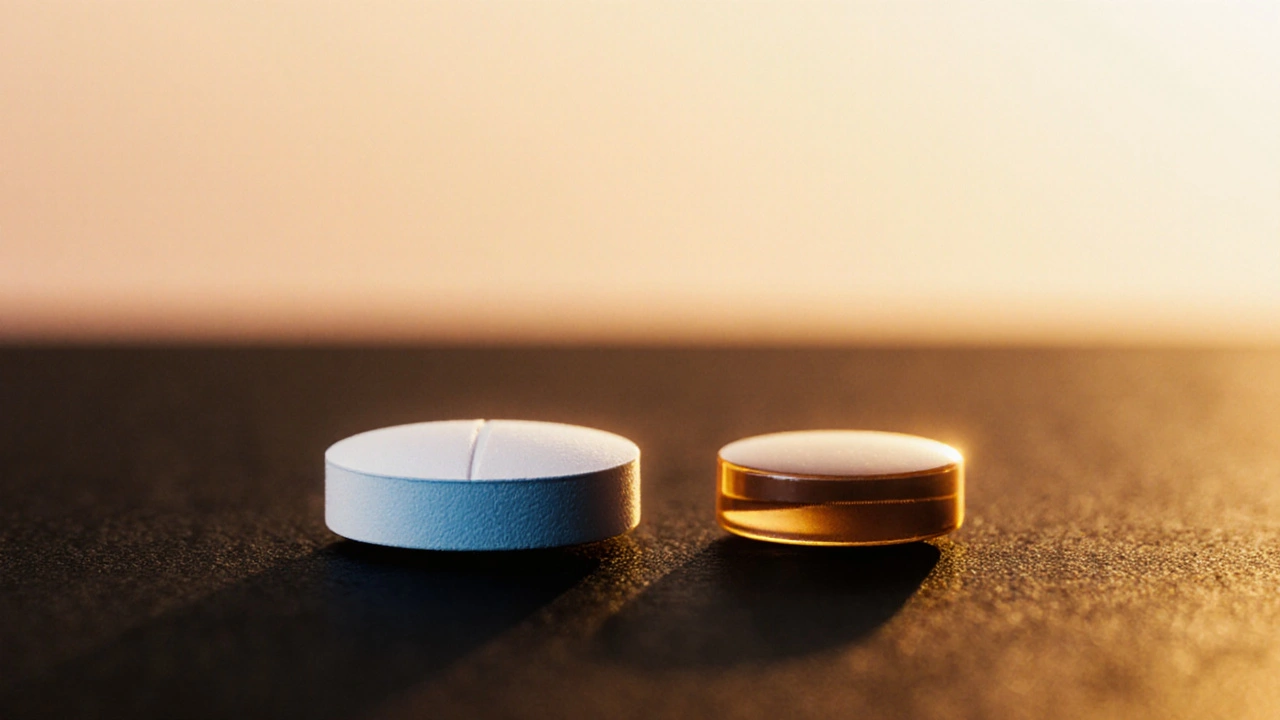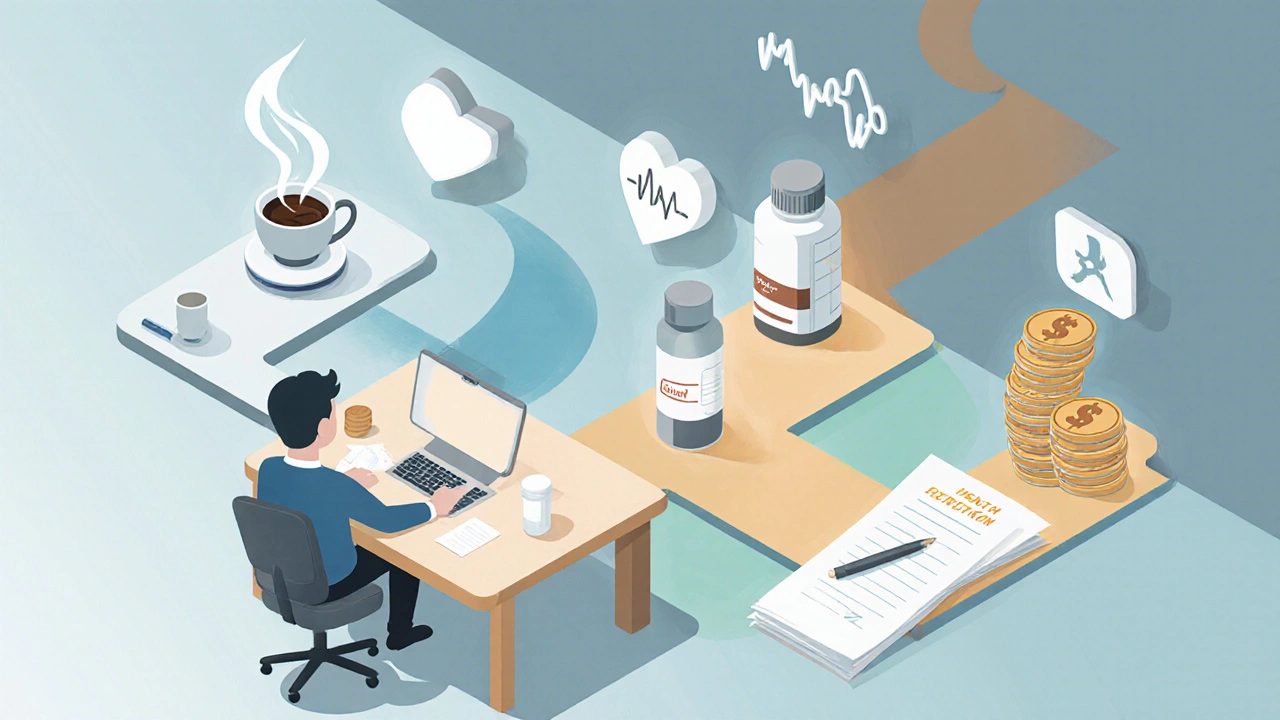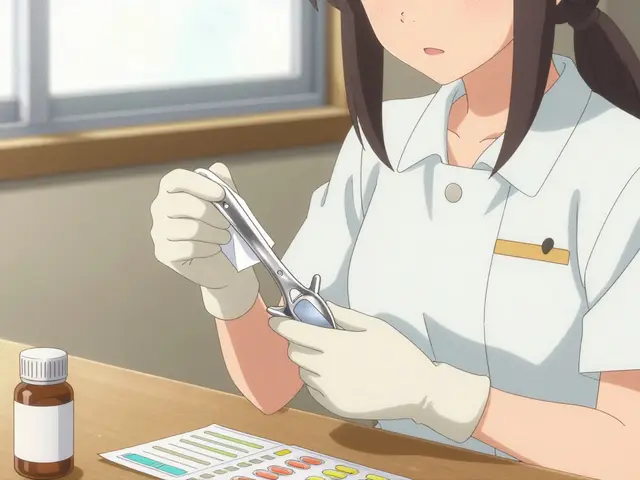
Wake-Promoting Agent Comparison Tool
Recommended Wake-Promoting Agent
Detailed Comparison
Quick Summary
- Waklert (Armodafinil) is the R‑enantiomer of Modafinil, offering a longer half‑life and steadier wakefulness.
- Onset is 30‑60minutes; peak plasma at 2‑4hours, making it ideal for daytime productivity.
- Common alternatives include Modafinil, Adrafinil, Pitolisant, Sodium Oxybate, Caffeine, Methylphenidate, and Dexamphetamine.
- Key decision factors: prescription status, cost, side‑effect profile, and duration of action.
- For most healthy adults seeking a predictable, 12‑hour window, Waklert often tops the list, but price and insurance coverage can tip the scales.
What Is Waklert?
When building a picture of wake‑promoting meds, Waklert is a brand‑name formulation of armodafinil, the pure R‑enantiomer of modafinil. It received FDA approval in 2012 for narcolepsy, obstructive sleep‑apnea‑related excessive daytime sleepiness (EDS), and shift‑work disorder. The drug works by selectively activating the brain’s arousal pathways, boosting dopamine, norepinephrine and histamine without causing the jittery spikes typical of stimulants.
How Does Armodafinil Differ From Modafinil?
Both drugs share the same chemical backbone, but armodafinil contains only the R‑enantiomer, which is metabolically more stable. In practice this means:
- Longer half‑life: ~15hours vs 12hours for modafinil.
- More consistent plasma levels, reducing the “mid‑day crash” some users report with modafinil.
- Similar safety profile - headache, nausea, and mild insomnia are the most common side effects.
Because of the extended coverage, many clinicians prescribe a single 150mg dose of Waklert in the morning, whereas modafinil often requires a 200mg dose with possible split‑dosing.
Key Attributes Compared Across Popular Alternatives
| Agent | Typical Dose | Onset | Half‑Life | Prescription? | Average US Cost (30days) | Common Side Effects |
|---|---|---|---|---|---|---|
| Waklert (Armodafinil) | 150mg once daily | 30‑60min | ~15h | Yes | $250‑$350 | Headache, nausea, insomnia |
| Modafinil | 200mg once or split‑dose | 45‑90min | 12‑15h | Yes | $150‑$250 | Dry mouth, anxiety, rash |
| Adrafinil | 300‑600mg | 60‑90min (pro‑drug) | 30‑45h (active metabolite) | No (over‑the‑counter) | $30‑$60 | Liver enzyme elevation, fatigue |
| Pitolisant | 5‑20mg once daily | 45‑120min | ~20h | Yes | $300‑$400 | Insomnia, nausea, anxiety |
| Sodium Oxybate (Xyrem) | 2‑9g nightly (split doses) | 15‑30min | 0.5‑1h (short‑acting) | Yes (restricted) | $800‑$1,200 | Depression, confusion, respiratory depression |
| Caffeine | 100‑200mg (1‑2 cups coffee) | 5‑15min | 3‑5h | No | Free | Jitters, increased heart rate |
| Methylphenidate | 10‑60mg daily (split) | 20‑30min | 2‑3h (immediate) / 8h (extended) | Yes | $150‑$250 | Appetite loss, insomnia, tachycardia |
| Dexamphetamine | 5‑30mg daily | 30‑60min | 10‑12h | Yes | $200‑$300 | Elevated blood pressure, anxiety |

When Might You Choose Waklert Over the Rest?
Think of your day as a 12‑hour work block. If you need a single, smooth boost that lasts right through without a second dose, Waklert’s longer half‑life shines. It’s also a good fit when you want a prescription‑only drug that’s less likely to trigger a liver‑enzyme warning - a concern with high‑dose adrafinil.
However, price can be a stumbling block. If your insurance covers Modafinil but not Waklert, the cheaper option may win. For those who prefer an over‑the‑counter route and are comfortable monitoring liver tests, adrafinil provides a budget‑friendly alternative.
Alternatives in Detail
Modafinil
Modafinil remains the most widely prescribed wake‑promoter. Its mixed‑enantiomer composition gives a slightly faster onset for some users, but the half‑life can feel “cut‑off” in the late afternoon, prompting a second 100mg dose. The drug is available as generic, making it cheaper than Waklert in most markets.
Adrafinil
Adrafinil is sold as a dietary supplement in several countries. It’s a pro‑drug that the liver converts to modafinil, which explains its longer half‑life (30‑45h). The downside? Regular users may see elevated ALT/AST liver enzymes, so quarterly blood work is advisable.
Pitolisant
Pitolisant is a histamine‑H3 receptor inverse agonist, a different mechanism altogether. It’s especially useful for patients who can’t tolerate dopaminergic agents. The drug’s half‑life (~20h) is comparable to Waklert, but it’s more expensive and still gaining traction outside Europe.
Sodium Oxybate (Xyrem)
This is not a traditional stimulant - it’s a central nervous system depressant used at night to improve sleep architecture, which indirectly reduces daytime sleepiness. Because it’s a Schedule III controlled substance, prescribing is highly regulated, and costs soar.
Caffeine
Everyone’s first go‑to. While the onset is lightning‑fast, the effect wanes after 4‑5hours. For short bursts (e.g., pulling an all‑nighter), caffeine works, but you’ll likely hit a crash later.
Methylphenidate & Dexamphetamine
These are classic psychostimulants approved for ADHD and narcolepsy. They provide a potent dopamine surge, which can feel “wired” compared to the smoother arousal from armodafinil. Side‑effects like appetite suppression and cardiovascular strain are more pronounced, making them less suitable for healthy adults seeking a mild boost.
Decision Guide - Picking the Right Agent
- Identify your primary goal: sustained 8‑12hour alertness vs short‑term burst.
- Check prescription requirements: If you lack a doctor’s visit, adrafinil or caffeine may be the only legal routes.
- Consider cost & insurance: Generic modafinil often costs half of Waklert; premiums may cover one but not the other.
- Assess health background: Liver disease → avoid adrafinil; hypertension → stay away from methylphenidate/dexamphetamine.
- Trial period: Start with a low dose (e.g., 50mg Waklert) and monitor side effects before scaling up.
Following this checklist will usually land you on the safest, most cost‑effective option for your lifestyle.
Potential Pitfalls & How to Avoid Them
- Mid‑day crash: If you notice sleepiness after 8hours on Waklert, consider a 100mg dose earlier in the day rather than a later boost.
- Drug interactions: Both armodafinil and modafinil induce CYP3A4 enzymes, potentially lowering oral contraceptive efficacy - use backup contraception.
- Tolerance: Long‑term daily use can dull the wake‑promoting effect. A weekend “drug holiday” helps reset sensitivity.
- Legal pitfalls: Importing Waklert without a prescription violates U.S. federal law. Stick to pharmacy‑filled scripts.
Frequently Asked Questions
Is Waklert stronger than Modafinil?
Strength is relative - Waklert contains only the R‑enantiomer, giving a more stable plasma level and a slightly longer duration. Many users feel the effect lasts a bit longer, but the peak alertness is comparable to a 200mg dose of generic Modafinil.
Can I take Waklert with caffeine?
Yes, but keep caffeine low (1‑2 cups) to avoid jitteriness. Both act on different pathways, so the combo can feel overly stimulating for some people.
What’s the biggest safety concern with Adrafinil?
Liver enzyme elevation. Routine blood work every 3‑4months is recommended if you use adrafinil long‑term.
Is Pitolisant suitable for someone with ADHD?
Pitolisant works on histamine receptors, not dopamine, so it does not address core ADHD symptoms. It’s primarily used for narcolepsy‑related sleepiness.
How long can I safely stay on Waklert?
Clinical studies support up to 12months of continuous use under physician supervision. Periodic evaluation for blood pressure, mood changes, and sleep quality is advised.





Comments (15)
Neber Laura
Waklert may sound fancy but it's just overpriced hype.
Karen Nirupa
Dear community, I have taken the liberty of reviewing the comparative data presented in the article. The author has meticulously compiled an extensive table of pharmacokinetic parameters, which is commendable. It is noteworthy that the half‑life of armodafinil extends beyond that of modafinil, offering a prolonged period of alertness. Nevertheless, the financial implications cannot be overlooked, particularly for individuals without comprehensive insurance coverage. Furthermore, the discussion of hepatic considerations for adrafinil is both prudent and essential for informed decision‑making. I would additionally recommend monitoring blood pressure when considering stimulants such as methylphenidate or dexamphetamine. In terms of safety, the inclusion of sodium oxybate as a nocturnal therapy reflects an awareness of sleep architecture. Lastly, the article’s emphasis on individualized goal‑setting aligns with best practices in clinical prescribing. I trust that readers will find this synthesis valuable in navigating their therapeutic options.
Quinn Comprosky
When evaluating wake‑promoting agents it is essential to consider both pharmacodynamic and pharmacokinetic properties the author has provided a solid foundation for such an analysis the extended half‑life of armodafinil compared to modafinil means that a single morning dose can sustain alertness well into the afternoon for many users the onset of action for armodafinil is relatively rapid allowing users to experience benefits within an hour the metabolic pathway of adrafinil involves hepatic conversion which raises concerns about liver enzyme elevations especially with chronic use the cost differential between generic modafinil and brand name Waklert can be substantial and may influence patient adherence the side‑effect profile of each agent varies with armodafinil commonly causing headache nausea and insomnia while modafinil may produce dry mouth anxiety or rash caffeine offers a low‑cost option but carries a high risk of jitteriness and a shorter duration of effect methylphenidate and dexamphetamine are potent stimulants that provide a strong dopamine surge but also increase cardiovascular risk the histamine‑H3 inverse agonist pitolisant presents a novel mechanism that may be advantageous for patients intolerant to dopaminergic drugs sodium oxybate is a unique nocturnal therapy that improves sleep quality and thereby reduces daytime sleepiness the table included in the article effectively highlights these distinctions however it would be beneficial to add a column for drug interaction potential especially regarding CYP3A4 induction the recommendation algorithm could be refined by incorporating patient-reported outcomes to personalize choices the author's suggestion of a weekend drug holiday is sound practice to mitigate tolerance and dependence finally ongoing monitoring of blood pressure mood and liver function remains a cornerstone of safe long‑term use
Thomas Ruzzano
Ah, the classic “big pharma” hype train-just another pricey pill with a fancy label. If you enjoy paying extra for the same buzz, go ahead. Otherwise stick to the cheap coffee.
Dan Tenaguillo Gil
Allow me to expand on a few practical considerations that often escape the initial comparison. First, when selecting a wake‑promoting agent it is wise to start with the lowest effective dose and titrate upward based on individual response. Second, keep a simple diary noting the time of ingestion, perceived alertness levels, and any adverse sensations such as headache or gastrointestinal discomfort. Third, be mindful of potential drug‑drug interactions; for instance armodafinil and modafinil are known inducers of the CYP3A4 enzyme system and may lower the efficacy of oral contraceptives or certain antiviral medications. Fourth, patients with a history of hypertension should have their blood pressure checked regularly if they opt for stimulants like methylphenidate or dexamphetamine. Fifth, liver function tests are advisable for anyone using adrafinil on a long‑term basis due to its hepatic metabolism. Sixth, consider the timing of the dose relative to your circadian rhythm-taking the medication too late in the day can impair nocturnal sleep. Seventh, insurance coverage varies widely; many plans list generic modafinil as a preferred formulary while brand‑name armodafinil may require prior authorization. Eighth, if cost is a primary barrier, exploring reputable online pharmacies that offer certified generic versions can be a safe alternative. Ninth, always discuss any mental health concerns with your prescriber, as wake‑promoting agents can occasionally exacerbate anxiety or mood swings. Finally, maintain open communication with your healthcare provider to adjust therapy as needed for optimal safety and effectiveness.
Tiffany Owen-Ray
I appreciate the thorough breakdown you provided; it mirrors the nuanced approach many of us seek when navigating these options. Your emphasis on titrating dose and tracking outcomes aligns with a mindful, self‑reflective practice. Moreover, the reminder about hepatic monitoring for adrafinil underscores the importance of holistic health stewardship. In my experience, pairing a steady wake‑promoter with consistent sleep hygiene yields the most sustainable productivity. Ultimately, the philosophical balance between external augmentation and internal rhythm is where true alertness resides.
Jill Brock
Wake‑up, folks! The endless debate over armodafinil vs modafinil feels like watching a soap opera where the villains are overpriced pills and the heroes are cheap coffee. I’m tired of the same recycled arguments about cost and half‑life. Give me a straight answer: does anyone actually feel the difference or is it just marketing fluff? The drama of “choose your poison” is exhausting, and we need real‑world experiences, not just charts.
Ellie Chung
Picture this: a midnight lab where scientists brew a potion of alertness, sprinkling in half‑life metrics like confetti. The audience watches, expecting fireworks, yet the real spectacle is the quiet hum of a mind finally staying awake. Your theatrical complaint captures the chaos, but perhaps the real art lies in finding the subtle brew that fits your rhythm without the melodrama.
Sophia Simone
While the preceding discourse admirably delineates the pharmacological landscape, one must caution against an overreliance on quantitative metrics alone. The qualitative experience of wakefulness, encompassing subjective vitality and cognitive clarity, often eludes mere statistical representation. Furthermore, the ethical ramifications of promoting off‑label usage merit rigorous scrutiny. It would be remiss to disregard the sociocultural context in which these agents are consumed, particularly with regard to occupational pressures. Accordingly, a holistic appraisal must integrate biomedical data with psychosocial variables to truly inform judicious selection.
Juan Sarmiento
Great points! I totally agree that we can’t just look at numbers. Real‑world feel matters a lot. Balancing the data with how you actually perform day‑to‑day is the sweet spot. Keep sharing those insights and we’ll all get smarter about our choices.
Patrick McVicker
lol this stuff is wild 😂👍 gotta love the hustle when you need that extra boost!
Liliana Phera
The pursuit of perpetual alertness betrays a deeper existential dread, a refusal to accept human limits; it is a rebellion against our own mortality that smacks of hubris. Yet the very chemicals we ingest to stave off fatigue only magnify the illusion of control, feeding a vicious cycle of dependence. If we truly sought wisdom, we would temper our cravings with humility, acknowledging that wakefulness is but a fleeting window, not a perpetual state to be engineered. Therefore, choose your agents with discernment, not desperation.
Dean Briggs
I concur with the sentiment that collaborative discussion enriches our understanding of these compounds. By sharing personal anecdotes alongside empirical data we construct a more robust knowledge base. It is through this collective wisdom that we can navigate the trade‑offs between efficacy, safety, and cost. Moreover, respecting diverse perspectives fosters an inclusive environment where novices feel empowered to ask questions. Let us continue to contribute thoughtful observations, cite relevant studies, and support one another in making informed decisions that align with both health goals and personal values.
Mariana L Figueroa
Quick tips: start low dose and monitor effects
track sleep quality with a simple journal
avoid mixing with alcohol
stay hydrated and maintain regular meals
consult a doctor before combining with other prescriptions
mausumi priyadarshini
Indeed, the comparative table, while comprehensive, - and I say this with due respect - could benefit from additional columns, for example, drug‑interaction potential, or perhaps a rating of tolerability, which many readers, particularly those new to pharmacotherapy, might find exceedingly useful; consequently, a more nuanced presentation would undeniably enhance the utility of the resource.